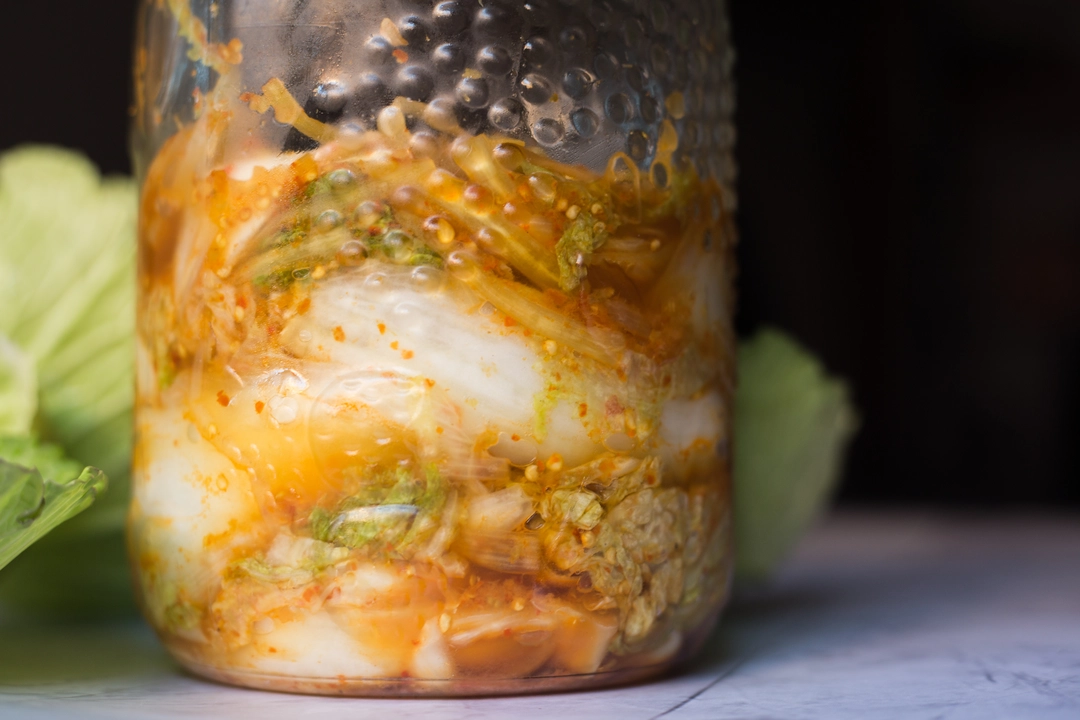Anyone who has been following me for a while knows my kimchi obsession. For its characteristic flavor, for fermentation, for chili, garlic and ginger, for its properties and history. Indeed stories, probably one for each family that traditionally does it.
Year after year I try this preparation, choosing one of its many variations each time. This time I used Chinese cabbage and daikon, lots of ginger, carrot, garlic and chili (but not the Korean one, which they tell me is the real plus). In particular, I followed some of the indications on the fermentalista.com site, including the 6% brine which is well explained on the site. I also kept the indications regarding the quantities valid, varying them slightly according to my taste. Last year I followed a recipe that provided for an excessive use of salt, but this year the generic criterion of calculating 6% of the quantity of salt on the total seemed to me a valid, well-motivated alternative.
In fact, the final result satisfied me both in terms of flavor and smell (which at the moment is my great yardstick to understand if fermentation has occurred, as well as an accurate analysis of the product to check for any mold formation).
This is a very spicy and hot kimchi.
Year after year I try this preparation, choosing one of its many variations each time. This time I used Chinese cabbage and daikon, lots of ginger, carrot, garlic and chili (but not the Korean one, which they tell me is the real plus). In particular, I followed some of the indications on the fermentalista.com site, including the 6% brine which is well explained on the site. I also kept the indications regarding the quantities valid, varying them slightly according to my taste. Last year I followed a recipe that provided for an excessive use of salt, but this year the generic criterion of calculating 6% of the quantity of salt on the total seemed to me a valid, well-motivated alternative.
In fact, the final result satisfied me both in terms of flavor and smell (which at the moment is my great yardstick to understand if fermentation has occurred, as well as an accurate analysis of the product to check for any mold formation).
This is a very spicy and hot kimchi.
Method
Thoroughly wash the coppa leaves / Chinese cabbage. Cut them into quarters lengthwise. Prepare the brine following the instructions on the site that I have reported to you. Immerse the Chinese cup in the brine and leave it to soak for about 6-8 hours, then turn them in such a way that this rotation guarantees the soaking of the vegetable in brine and leave them for another 6-8 hours.
Drain the leaves from the brine and rinse them very well (at least 3 times with cold water), in order to remove some of the salt.
With the help of a spoon, scrape the ginger peel and cut it into small pieces. Peel and crush the garlic. Blend them together with the chilli until you get a paste, or crush them in a mortar.
Put on latex gloves to protect your hands and spread the freshly made chili paste on the leaves of the cup. Pass well leaf by leaf until all are completed.
Sterilize a jar (in the oven at 100 ° C for half an hour, then leave it to cool slowly in the oven). Usually, jars with ceramic or glass caps are used, also because the brine will tend to rust those of metal over the months.
Put the kimchi in the pots (s), in layers, rolling the leaves on themselves and squeezing each layer. At the end, place a weight (eg a bowl) in such a way that the weight exerted on the kimchi causes the vegetation water to flow out until it covers the fermented product.
Leave out of the fridge overnight with the jar not hermetically closed, so that it can vent during the first fermentation phase. Then transfer it to the refrigerator, making sure to check that the kimchi is always covered by the liquid.
TO MAKE KIMCHI YOU NEED ALMOST 2 DAYS.
Preparation time
about 24 hours
